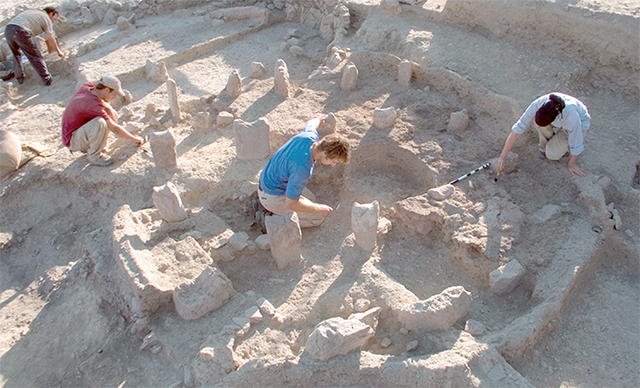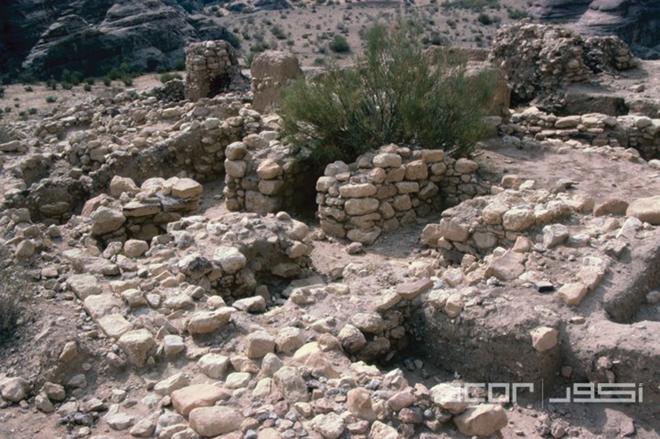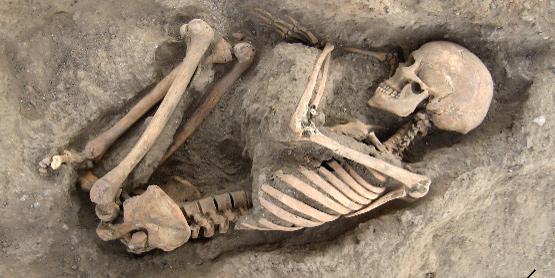You are here
Dhra Neolithic site unveils world’s oldest grain silos
By Saeb Rawashdeh - Jan 04,2024 - Last updated at Jan 04,2024

The outer walls of the structure, which was constructed 11,300 –11,200 BC, are defined by a partially preserved mud wall (Photo courtesy of Bill Finlayson)
A Neolithic village Dhra is located at the southern end of the Dead Sea area, near Wadi Karak, in southern Jordan. The site was occupied in the Pre-Pottery Neolithic at around 9,500BC, covering an area of one hectare.
The first teams visited the site in the 1970s, but the more serious study of Dhra began in 2001 and 2005. Dhra stands as one of the most significant Neolithic sites in southern Jordan, boasting a long history of occupation.
Professor Emma Jenkins from Bournemouth University first excavated in Jordan in 2007 and her doctoral research focused on micro-fauna (small mammals and amphibians) at the Neolithic site of Dhra.
“My research allowed the directors of the project to confirm that structures they had found there were the earliest grain silos currently known in the world.
“I concluded this because huge densities of barley phytoliths, particularly from the husks, were found on the floor of one of the structures that was believed to be a silo,” Jenkins said, adding that she worked at the University of Reading with Professor Steven Mithen and became involved with sites in the Wadi Faynan where they excavated a 12,000-year-old settlement.
“The site comprised a range of small semi-subterranean buildings made of the local clays and plants and one very large building, which had a series of benches and appeared to be some kind of communal structure.
“It had patterns engraved on the sides of the benches and post-holes suggesting that it must have had some type of roof. At this site, we found a large number of human burials, animal bones, plant remains, small art objects, such as stones with human faces incised on them, small stones with other types of engravings, beads, and ground and chipped stone tools. Wadi Faynan 16 is an amazing site and I was very fortunate to get the opportunity to work there with such an amazing team of archaeologists,” Jenkins underlined.
Jenkins has been involved with the INEA project, which studies various Neolithic sites in Jordan.
“Taking part in excavations at a number of Neolithic sites, from small ephemeral campsites to large permanently occupied settlements, fascinated me with how Neolithic settlements were constructed and used. In order to try and learn more about this, I led a project known as the INEA with Director Carol Palmer from the Council for British Research in Levant [CBRL], who has a long background in ethnographic research,” the professor noted, adding that the team studied soil samples from several occupied and abandoned Bedouin campsites and also an abandoned village known as Al Ma’tan which had been constructed during the 1920s and 1930s.
This village was made by using local clays and plant materials much like some of the Neolithic settlements, and also had some similar features such as clay storage bins, sleeping platforms, wall niches and internal hearths, Jenkins elaborated, noting, “We were able to speak to the residents and former residents of the Bedouin campsites and of Al Ma’tan and ask questions about how the sites were constructed and utilised.
“This helped us understand more about Neolithic occupations and how long indicators of human activity remain within the sediments, and it has made me look at Neolithic settlements differently.”
The INEA team studied seven Bedouin tent sites and three buildings at Al Ma’tan and the environmental archaeologist Sarah Elliott, who was a post-doctoral research assistant on the INEA project, continued this work as part of a British Academy funded Research Fellowship in partnership with the CBRL and looked at more vernacular buildings, she elaborated. However, the COVID-19 pandemic hindered some of these plans so the team is planning to resume the project in the coming period.
“So our research on the INEA project focused on ethnographic sites which were constructed and used in the 20th century but we also then compared our findings to the Neolithic sites such as ‘Ain Ghazal and Wadi Faynan 16,” Jenking concluded.
Related Articles
AMMAN — The study of modern society and modern people can help answer archaeological questions, according to British scholar Sarah Elliott.“
AMMAN — The Neolithic period is rich in archaeological remains that show most of the fundamental developments in human history, noted a Jord
AMMAN — The earliest human burials found in Faynan, some 140km south of Amman, come from the early Neolithic site of WF16 and date back to 1


















